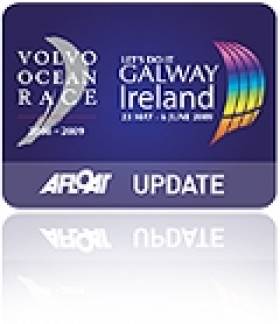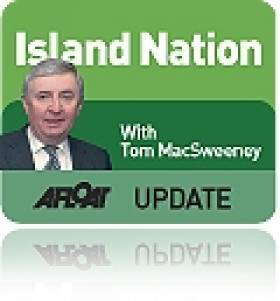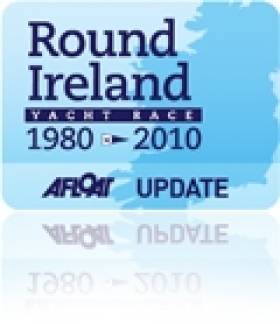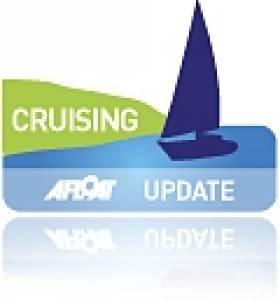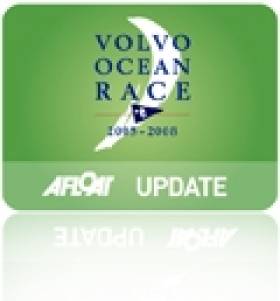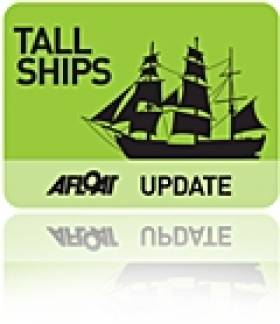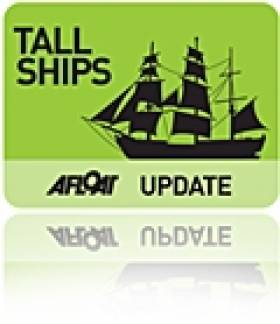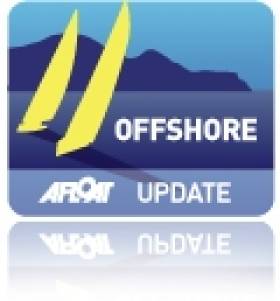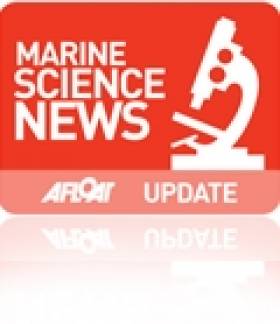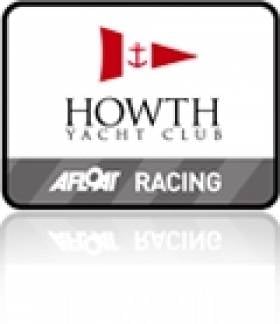Displaying items by tag: Volvo Ocean Race
Let's Do It Global, the organisation behind the Galway finish of the Volvo Ocean Race in 2012 are announcing plans for the race Festival in Galway on Friday.
The organisation's Chairman Mr. Enda O'Coineen will also announce a new business platform, 'Global Village 2012 '.
Cheeky Chinese Challenge?
This is an interesting challenge to the present US holders, computer software billionaire Larry Ellison's Oracle Racing team which decided to have the event hosted by the San Francisco Yacht Club, which prides itself as being "the oldest club West of the Mississippi in North America."
It will be the first time the America's Cup has been hosted in the United States since 1995 and it is interesting to speculate whether the Chinese are cheekily challenging the Americans who don't like the Cup going outside of the States.
Racing will be held on the iconic San Francisco City front and be visible from world-renowned tourist destinations such as the Golden Gate Bridge.
"My support for San Francisco hosting the America's Cup goes beyond the opportunity to see our team competing on home waters," said Russell Coutts, CEO, ORACLE Racing. "We are excited to sail for our sport's greatest trophy, on a stretch of water legendary among sailors worldwide."
The China Team has been given the backing of the Chinese Government and has already been designing a boat for the 34th Cup event which will be raced in 72-foot wing-powered catamaran multihulls.
"We have been working with some of the best worldwide designers for hulls and wings for a few months in partnership with top Chinese universities," the Team Leader, Wang Chao Yong, said. "This is an opportunity to showcase Chinese talents at the leading edge in hi-tech areas of both hydrodynamics and aeronautics. Our boat will be built in China."
The Chinese made an unsuccessful attempt on the 2007 America's Cup. While the intention is that most of the sailors on their America's Cup team will be Chinese there is to be, as in the 2007 attempt, a French influence. Thierry Barto has been appointed Chief Executive Officer and given the task of getting top sailors to coach the Chinese team.
It seemed initially that interest might be lacking in the 162-year-old event. However ten teams have signed up to take part in the 34th America's Cup.
Aside from the defender, Oracle, entries include Team New Zealand, Italian syndicate Mascalzone Latino - the official challenger of record - and Artemis of Sweden. Two French teams and the Chinese have also paid their entry fees. America's Cup Racing Management says two other unidentified teams, one of which is believed to be Italy's Venezia Challenge, will take part. Whether all of the existing entries make it to the start line of the challenger elimination series in July of 2013 will be interesting. There was major legal action before the event was re-scheduled for 2013. Oracle and Ellison declared their preference for a defence in San Francisco as the "home club".
Two of the three possible French challengers had talks with the Minister for Sport in Paris last Friday to discuss amalgamation and whether there would be French government support. There is also an "Argo Challenge" from a group of disabled sailors.
• This article is reprinted by permission of the EVENING ECHO newspaper, Cork, where Tom MacSweeney writes maritime columns twice weekly. Evening Echo website: www.eecho.ie
Before the race got on the water, the scene was set onshore with a storyboard lifted from Galway '09. In a bid to mirror the Volvo Ocean Race stop-over, the Round Ireland was smartly enmeshed with a successful town festival in Wicklow, drawing in thousands of non-sailing civilians, many of whom hung out on the cliffs to watch one of the best-attended starts in years.
The backbone for this year's story was Tonnerre de Breskens III, owned by Dutchman Piet Vroon. The crew arrived in Wicklow with a brace of RORC victories, leading RORC's offshore table, and went into the race as favourites. The first twist in Tonnerre's plot came before the starter's gun, when Vroon ended up in hospital, from where he would follow the race as his crew sailed on without him. However, that would be the only bump in their road. Tonnerre led from start to finish, both on the water and on handicap. Vroon's crew brought home the trophy for their ailing skipper in the race's happy ending.
There was drama in their wake, though. Not the high-octane 60-knot knock-down drama of 2008, but good stuff nonetheless. Bernard Guoy's Inis Mor chased hard to no avail, and in the end they just couldn't do it. Theirs was the story of the weary, the plucky but the ultimately unlucky. In 2008 gear failure put them out of the running, but in 2010 it was Tonnerre's sheer perfection that relegated Inis Mor to the runner-up spot. You would be hard pressed to find an error in their race, and they deserved the second slot.There were other big guns, of course. Mick Liddy and Mark Pollock's Daft.com Class 40 was a drama mini-series all of its own, with a blind co-skipper in a high-powered double-hander seeming a deluded concept to many. Until the batteries died they were churning out their own stories, uploading video content to beat the band. Of course, directorial priorities shifted when their electrics went as they headed up the west coast. Pollock's input was limited to nearly nil without electronics, meaning Liddy became all but a solo sailor without relief, helming non-stop for four days. Their initially promising position was eroded in the last third of the race as fatigue bit hard.
No similar excuses for the biggest boat in the race, the Open 60 Spirit of Rosslare Europort, which by all accounts should have made hay in some heavier airs off the west coast and come home first for line honours. However, they couldn't capitalise on that. Some will say that Tonnerre was better suited to the conditions than the larger Open 60, while others will dismiss that as folly.
The dogfights, then, the meat-and-veg of the story, were in IRC 1. Visit Malta Puma, another hot contender from the Solent, was in charge for much of the race while things were quietly making their way up the west coast. In the Round Ireland, as in Irish history, things have a way of kicking off around the north-east corner. As the tides and light airs played with the fleet, the lead changed hands six times between Inistrahull and the finish, with Fujitsu and Visit Malta Puma match-racing down the Irish Sea, and Bejaysus and Aquelina doing the same behind them.
Visit Malta Puma would emerge victorious, and in the meantime, the leaders of Class 2 and the double-handers were passing the mouth of Strangford Lough and crossing Dundrum Bay. Psipina and Dinah would trade tacks all the way to Wicklow, with Paddy Cronin in Psipina (joined by John Loden) making it two in a row in the two-handers overall. Second place, however, would go to one of the backmarkers.
Theirs was the rags-to-riches tale of this Round Ireland. Brians Flahive and Byrne took a boat all but written off and kitted it out for the 704-mile offshore. Noonan Boat Oystercatcher was the racing equivalent of a transplant patient, with a large portion of its port side removed and rebuilt by its owner, boatbuilder Graham Noonan, also Flahive's boss. Ten days before the race, the pair were rigging the tiny Gibsea with a spinnaker for the first time, and as the front of the fleet slowed, they rocketed on into second, not bad for a major offshore debut.
And while champagne corks were popping on land, there were still cups of tea being handed up to the rail from many galleys along the Irish Sea coast. The finish to the Round Ireland was prolonged, but deciding the results was not as strung out an affair as years gone by, the winner having been decided well in advance of the last finishers' arrival.
The question mark at the end of this story leaves things open for an innovative sequel. Dropped into the narrative mid-race were questions in the national media over how more racers might be tempted to Wicklow for 2012. The festival was, no doubt, a good start, but what of the date? Would moving it away from the annual date of the 1700-boat Solent carnival that is the Round the Island, putting further distance between it and Cork Week make sense? Would it make for a greater foreign entry? Eight of the 36 entries this year were from outside of Ireland - who's to say that couldn't be doubled or tripled?
That's a script yet to be written. For Round Ireland 2010, the credits are rolling. Wicklow SC can be proud that they delivered yet another successful edition of Ireland's classic offshore, and the various actors can take a deserved bow for playing their part in another home-produced oceanic drama.
Round Ireland Yacht Race 2010 Trophy Winners
Line Honours - Denis Doyle Trophy
Tonnerre de Breskens 3 - Piet Vroon
IRC Overall - Norman Barry Trophy
Tonnerre de Breskens 3 - Piet Vroon
Inis Mor - Bernard Gouy
Visit Malta Puma - Philippe Falle
Class 7 / Two Handed - The Noonan Trophy
Psipsina - John Loden & Paddy Cronin
Noonan Boats Oystercatcher - Brian Flahive
& Bryan Byrne
Alchimiste - Michael Murphy & Alex Voye
Class Super 0
Spirit of Rosslare Europort - Alan McGettigan
Class 0 - Mew Island Trophy
Tonnerre de Breskens 3 - Piet Vroon
Inis Mor - Bernard Gouy
Pride of Wicklow - James Gair/David O'Gorman
Class 1 - Tuskar Cup
Visit Malta Puma - Philippe Falle
Fujitsu - Andrew Britton
Aquelina - James Tyrrell
Class 2 - Fastnet Cup
Raging Bull - Matt Davis
Psipsina - John Loden & Paddy Cronin
Dinah - Barry Hurley & Hannah White
Class 3 - Skelligs Cup
Noonan Boats Oystercatcher -
Brian Flahive & Bryan Byrne
Alchimiste - Michael Murphy & Alex Voye
Cavatina - Ian Hickey/Eric Lisson
Class 4 - Tory Island Trophy
Noonan Boats Oystercatcher -
Brian Flahive & Bryan Byrne
Cavatina - Ian Hickey/Eric Lisson
Gumdrop - Derek Gilmore
Class 5 / Classic - Michael Jones Trophy
Cavatina - Ian Hickey/Eric Lisson
Class 6 / Sigma 38 - Larry Ryan Trophy
Persistance - Jerry Collins
ISORA Trophy
Raging Bull - Matt Davis
Irish Cruiser Racing Association -
Round Ireland Trophy
Aquelina - James Tyrrell
Team Kinsale Yacht Club Trophy
Team 'RORC': Tonnerre de Breskens 3 - Piet Vroon / Visit Malta Puma - Philippe Falle / Psipsina - John Loden & Paddy Cronin Team 'Go Hard or Go Home': Pride of Wicklow - James Gair/David O'Gorman / Aquelina - James Tyrrell / Noonan Boats Oystercatcher - Brian Flahive & Bryan Byrne
More on the Round Ireland Yacht Race:
Round Ireland Yacht Race 2010 Review
Round Ireland Yacht Race, Ireland's top offshore fixture
A Round up of 80 stories on the 2010 Round Ireland Yacht RaceIrish Cruising Club Present Fastnet Award to Killian Bushe
So whenever a high-powered strongly-resourced international challenge is taking shape, Bushe is the boat-builder of choice, favoured by leading designers and top skippers alike. But if you have a challenge in mind and he is top of the list, please join the queue.
For at the moment, he is immersed as leading consultant in building the new Groupama 4, the top French Volvo 70 for Franck Cammas. Before that, he built the two successful Ericsson boats for the last Volvo – they took first and fourth. In fact, he has built the overall winners of the last three Volvo races. And when Groupama 4 is launched in May and signed off for the race (which starts on October 29th) Bushe returns his focus to Sweden which is now his home, where he has been involved with the Artemis challenger for the America's Cup 2013.
For that project, the designer is Juan Kouyoumdjian, and the skipper is Paul Cayard. This is stratospheric stuff, but that's the level where Bushe operates. With more than thirty years of high tech boat building experience, and a string of success that is mind-boggling, he is the gold standard. But beyond that, he is still the Crosshaven kid who started his racing on his father George's Avocet (which George designed and built), and internationally he is the spirit of Cork sailing.
His renowned skill and knowledge in the use of advanced materials and composites is such that you'd expect him to be awarded a Honorary Doctorate in chemistry from some appropriate university. But in the meantime, his special place in Irish and world sailing was honoured on Saturday March 26th with his award of the Fastnet Trophy.
This trophy is co-ordinated by the Irish Cruising Club, and it operates in very broad brief. Initiated in 2005 with its first award to Paddy Barry and Jarlath Cunnane for their pioneering circuit of the Arctic via both the Northwest Passage and the Northeast Passage, its unique lineage has been maintained by such awardees as Robin Knox-Johnston, and the most recent one, centenarian circumnavigator Bill King of Galway.
The Fastnet Trophy is envisaged as highlighting a contribution to sailing which has a sense of the unique about it, and Killian Bushe is just the man. His international sailing achievements began back in 1976 when he was one of the crew that won the Half Ton Cup at Trieste in the Cork-built Silver Shamrock. They celebrated by sailing up the Grand Canal in Venice with spinnaker set. But gradually the boat-building took over, though Bushe sails with his family in Sweden whenever he can. That is what was being celebrated on Saturday night. Killian Bushe – very good sailor, extremely good boatbuilder.
Crucial Stage for Volvo Ocean Race Sponsorship Talks
Negotiations to land €11 million in sponsorship for the finals of the Volvo Ocean Race in Galway next summer are at a 'delicate stage', the Galway City Tribune reports.
Six teams have so far been confirmed for the world's biggest sailing event, and Irish organisers are in talks with a number of potential overseas sponsors.
“We are at a delicate stage in negotiations in relation to a number of issues and plans are on track for a much bigger event this time around,” said John Killeen of Let’s Do It Global, a team that in its previous incarnation had Chinese sponsorship for its 2009 entry in the race.
The Volvo Ocean Race is set to attract more than half a million visitors, with close to 50,000 corporate guests, and is expected to bring in €80 million for the local ecomony in Galway.
The Galway City Tribune has more on the story HERE.
Tall Order for Ireland
Sailing in Ireland could yet have a tall ship to replace the Asgard II and the Lord Rank. A meeting in Dublin in late March represents a major step forward in the process to put an Irish tall ship back on the high seas.
The open workshop, to be held on March 26th, will be facilitated by Dublin Port, and will include state interests, tourism interests, commercial port interests, youth organisations, maritime organisations and education groups, together with the former Lord Rank and Asgard II operators.
The catalyst for the initiative is a 'reference group' which represents a broad cross-section of interests, both North and South. Operating under the chairmanship of Lord Glentoran, and supported by Dr Gerard O'Hare, David Beattie and Enda O'Coineen, the group has also engaged a professional consulting firm to move the process along.
The initial focus is on the necessary organisation and rationale behind building a new vessel, while scientifically quantifying the benefits to build a plan and justification.
The view taken is that, while there may be no money available at this time, there is no excuse for not having a plan and the idea is to create ' joined-up' thinking. And while the government in the South placed the insurance money paid out on Asgard II back into general exchequer funds, the insurance payment on the Lord Rank was kept and ' ring-fenced' for this new initiative.
To date, there have been several meetings of the reference group. The planned workshop on the subject at Dublin Port March 26 is open and interested parties are invited to contribute. It will also bring together for the first time the leaders of Tallships in Dublin, Belfast, Waterford and Cork.
Ultimately Tall Ships is about youth training and development; without an active Tall Ship, it will be very difficult for Ireland to attract Tall Ship events. The new reference group will work to support the new Sail Training Ireland Association initiative, and link in with Sail Training International which runs Tall Ship events.
Following the Dublin workshop, Belfast Harbour Commissioners will host a working meeting of the group in early May to finalise a plan, present to stakeholders and create a roadmap forward.
"In addition to youth training, a working Tall Ship forms a brilliant ambassadorial role promoting tourism, enterprise and commercial interests," said Lord Glentoran. "It is something that we can all relate to and it has universal acceptance for youth training on an island of Ireland basis." Lord Glentoran has a long commitment to youth sail training and was Chairman of the organising committee that brought the Tall Ships to Belfast in 1991.
The reference group is seeking to engage with as many stakeholders as possible, and has pledged that the new vessel will be owned by the community in Ireland and the Irish Diaspora. The initial view is that the project clearly needs to be linked with the institutions of State - North and South - as are universities state agencies and ports, while at the same time having a strong private support network making for a mix of public and private funding, "We now have a brilliant opportunity to look around the world, establish best practice in the best kind of vessel, how to fund it and to quantify the benefits for each of the stakeholder group," said Enda O'Coineen, who has been instrumental in bringing the group together. In addition to being a former Coiste and Asgard Director, he is the founding Chairman of Let's Do It Global, which brought the Volvo Ocean Race to Galway and successfully raced the Green Dragon around the world.
O'Coineen added that a "world class solution" can be created and that its benefits can be financially quantified, which would allow supporters to make a compelling business case to divert and use existing funds in Tourism, Enterprise and Youth Training. "While there is no money available now to support the scale and professionalism needed, this is not an excuse not to have a plan and a vision," he added.
Since the loss of the Asgard II and Lord Rank, Ireland has been left with no sail training opportunities for young people and likewise for maritime development, enterprise and tourism. If nothing is done, future generations will suffer. The reference group believes that the solution is the construction of an Ireland - North and South - training vessel, fulfilling several roles with a common mission and resourced according to quantifiable benefits delivered to stakeholders. It is also open to the use of an existing vessel - a key component being suitability and the operations budget.
The proposed Tall Ship project will enhance skills and opportunities for young people across the island, regardless of background, class or education. It could be used to showcase Ireland as a brand at overseas events and it could also host international students who wish to come to the island of Ireland, as is the case with many of the International Tall Ships Programmes already running on a global scale which create a huge amount of tourism for their respective countries.
The reference group notes that the Tall Ships concept appeals to young and old alike as the romanticism behind the concept touches on history, social studies, legacy, family, travel, adventure and, most importantly, fun. Tall Ships allow people to dream. They do however have an underlying seriousness and the concept is grounded in methodology that has been tested and proven the world over.
An advertisement in March/April of Afloat magazine - out now - gives full detials of the 'Tall Ship for Ireland' Workshop
Should Ireland be represented at the Tall Ships Races at Waterford 2011 and Dublin 2012? We want your vote on our Facebook Poll HERE.
Looking for further reading on Tall Ships in Ireland? Click the links below:
Click this link to read all our Tall Ships Stories on one handy page
Previewing Ireland's Tall Ships 2011 Season
Waterford Tall Ships Plans Revealed
Waterford has unveiled its sailing plans to celebrate the arrival of the Tall Ships Race this summer.
The Irish Times reports that more than half a mllion people are expected to visit the city from 30 June to 3 July to see the majestic vessels - and they are set to be entertained by a variety of street events and live performances.
Sharon Shannon, The Waterboys and magician Keith Barry are among those lined up for the weekend's festivities.
Fáilte Ireland chair Redmond O’Donoghue compared the Tall Ships visit to the Volvo Ocean Race visits to Galway, and said it would be “a talking point for many years to come”.
A new multi-million euro jetty for Waterford Harbour designed to accommodate the ships will be ready in time for the race arrival.
The Irish Times has more on the story HERE.
Looking for further reading on Tall Ships in Ireland? Click the links below:
Click this link to read all our Tall Ships Stories on one handy page
Previewing Ireland's Tall Ships 2011 Season
Can Ireland Get a New Tall Ship?
Foxall to be Groupama Helmsman, Trimmer and Crew Manager
The Daily Sail website is reporting Foxall will take up the position of helmsman, trimmer and crew manager. More HERE.
Galway Atlantaquaria Nets Second Education and Outreach Award
Galway Atlantaquaria who, with the Marine Institute, Forfas Discover Primary Science and others are partners in the Explorers marine education and outreach programme, have achieved their second prestigious award - Best Education Project : Public and General Visitor 2010 - from the Britain and Ireland Association of Zoos and Aquaria (BIAZA) for their marine education and outreach activities.
The award, was presented at Paignton Zoo Environmental Park, Devon by Adrian Sanders MP and was given for the "Galway Marine Month of Madness" event, organised by the Atlantaquaria with help from the other Explorers partners during the month of May this year.
Speaking for the Atlantaquaria, Marketing Executive Colette Lavin said that the award was a tribute not only to the Atlantaquaria but to all those involved in the month-long celebration. "A lot of people put a lot of heart and hard work into the individual events that made up the Month of Marine Madness," she said. "And while this second BIAZA award is the most tangible benefit of all this, I really believe that the biggest reward for all our efforts is the raised awareness of the value of our oceans and seas, not only to Galway, but to the rest of the country."
The calendar of events was launched by Galway's Deputy Mayor Mr. Peter Keane at Salthill beach and events arranged during the Month of Marine Madness ranged from seashore safaris, diving lessons, scientific lectures, nature walks and angling demonstrations, to a series of free seminars at the Atlantaquaria on such subjects as Baleen Whales, Slimy
Seaweed, the value of outdoor education, and Pirates! The First Entrepreneurs. A highlight of the calendar was the 'Largest Beach Clean Up in Ireland' which took place on Sunday 18th of May. Over 2,000 members of the public took part in the various events which included a tour of the national research vessel RV Celtic Explorer by 280 pupils from local primary schools.
Speaking for the Explorers Programme, Dr. John Joyce of the Marine Institute said that the effort put in by Colette and her team had raised awareness of the sea to a whole new level in Galway during the month of May. "While Explorers is targeted primarily at raising awareness of the sea in schools, Colette and the Galway Atlantaquaria have shown us how we can raise that awareness to a whole new level by reaching out into the wider community. Last year, the Volvo Ocean Race vividly demonstrated the value of the sea to Galway in terms of tourism revenue. Clearly, the way is open to build on that awareness
and to use our creativity in finding new ways that Galway can profit - financially, educationally and environmentally – from marine related events."
Galway Atlantaquaria, the Marine Institute and the other partners in the Explorers programme celebrated the launch of National Science Week on Sunday 7th November with a Sunday Funday entitled "Our Plaice in Space" to celebrate the connections between outer and inner space.
Later in the month, on November 21st, the Explorers Programme will be present at the Galway Science and Technology Festival in NUI Galway.
Joe English Lunch in Howth Yacht Club
Howth Yacht Club is staging a lunch to help Round the World skipper Joe English who has been diagnosed with Alzheimers disease according to a note on the club website.
Coming from a career in sailing that started in 1976 in North Sails' Kinsale loft, Joe is probably best known for his role as Skipper of NCB, the Irish maxi yacht which competed in the 1989 Volvo Ocean Race.
He also took over as Skipper of Toshiba in the 1997 race. More locally, Joe was an innovator in the Cork 1720 project in conjunction with Tony Castro.
In recent years, Joe has been diagnosed with Alzheimer disease at a very young age and recently featured in a Prime Time documentary on RTE on the subject. A charitable trust has been launched to help Joe and his family over the coming years and this year's HYC Christmas lunch is to benefit this worthy cause.
The lunch is on Friday, 10th December




























